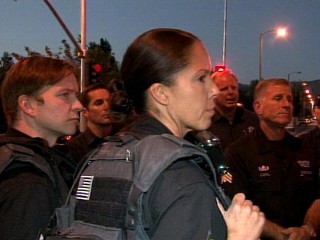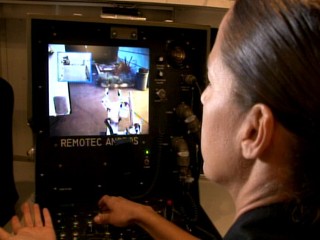|
.........
A Day in the Life of LAPD Bomb Squad
Making a Thousand Runs a Year, the Bomb Squad Can Never Relax
~~~~~~~~~~~~~~~~~~~~~~~~~~~~~~~~~~~~~~~~~~~~~~~~~~~~~~~~~~~~~~~~~~~~~~~~~~~~~~~~~~~~~
 |
 Los Angeles Police Department Bomb Squad member
Los Angeles Police Department Bomb Squad member
Officer Norma Stange listens to a safety briefing
before disposing of volatile explosives.
(ABC News) |
|
A Day in the Life of LAPD Bomb Squad
Making a Thousand Runs a Year, the Bomb Squad Can Never Relax
ABC News
by PierreThomas, Richard Esposito and Lenny Bourin
LOS ANGELES, Dec. 13, 2009
On a recent day the Los Angeles Police Department bomb squad answered what they thought would be a routine call: a woman showing up at a fire station with boxes of what she thought were only fireworks.
It turned out to be far more dangerous.
"The stuff has been stored for a long time," squad member Det. Kevin Corn said. "It could be unstable."
So the bomb squad decided to bring in their total containment vessel, or TCV, and in their words "just make it go away." That means wrapping the volatile chemicals in the squad's own explosives, putting it into the TCV and blowing it all up. |
| |
| Today, one of the squad's newest members, Officer Norma Stange gets the call. It's her first chance to use her training to dispose of real explosives.
While some bombs can be defused by remotes, often officers have to get up close and personal with potentially volatile explosive devices.
After putting on a protective suit, Stange walks gingerly, carrying the unstable chemicals that could ignite from something as simple as static in the air. She puts them in the TCV, which is a huge metal ball that sits on a truck body and is capable of safely detonating pounds of high explosives. Moments later, at a safe distance from the TCV, she pushes the trigger.
She jumps at the spark and almost instantly the explosives inside the TCV explode with a loud pop and smoke leaks out of the containment chamber. For Stange, it's an important first, and there are congratulations and backslaps.
"It's very exciting," she says with a big smile. "I'm glad it was successful."
On this day, all ends loudly, but well. Still, in the background, the squad members worry about what nightmares might lie ahead. |
 Los Angeles Police Department Officer Norma Stange,
Los Angeles Police Department Officer Norma Stange,
a member of the department's bomb squad, works with
a remote-controlled robot to defuse a pipe bomb.
(ABC News) |
|
The LAPD bomb squad makes about a thousand runs every year. Most turn out to be nothing. But the squad can never relax.
They've all seen pictures of devastating bomb attacks from Afghanistan and Iraq and other world hot spots, images that are always in the back of their minds.
"That threat has developed overseas, and certainly intelligence sources tell us it's something we may have to deal with here," says Lt. Rick Smith, the officer in charge of the bomb squad. In fact, the bomb squad has seen it before. In 1979 the Alphabet Bomber killed three people at Los Angeles International Airport. In 1990, a 2000- pound truck bomb was parked outside the Internal Revenue Service office in West L.A., though it failed to explode.
And Ahmed Ressam, the so-called Millennium Bomber, was stopped at the Canadian border on his way to detonate another bomb at LAX in 2000.
"We have to worry about the professionally trained al Qaeda terrorist who's coming over here to attack a major sporting event or airport, down to someone simply experimenting in their garage, or someone perhaps who's mainly upset at one or two people, a business partner or ex-wife," said Det. Sgt. Paul Robi, one of the squad's supervisors. |
Los Angeles authorities are prepping for the worst, investing millions in state-of-the-art technology. The most unique new tool in the squad's arsenal is the Bat Cat, the first one to be deployed in the United States. It looks like something from a construction site with an extendable arm, but is powerful enough to pick up a large truck loaded with explosives and move it from a densely populated area to a safe place.
"We could literally pick up a car bomb and move it if we needed to," Smith said.
There is a mobile command center with the latest communication equipment and more, such as robots equipped with cameras and a claw.
"What it allows us to do is bring all of the tools of the trade," Smith said.
With these high-tech tools, bomb squad officers like Stange can handle explosives by remote control.
"If there's a pipe bomb, we can use the robot and go up to the pipe bomb, if we needed to move it," she said.
Stange has been on the LAPD for 13 years, but only recently joined the bomb squad.
She says the reason she wanted to make the move is "the excitement."
"It's just such a challenge, every call is different," she says with a big smile. "It keeps you on your toes, you have to be creative, you have to think outside the box."
But along with the excitement comes the need to be thoroughly trained and to move with great caution. It's a job filled responding to the routine, but preparing for the unimaginable. |
|
|
 |

|